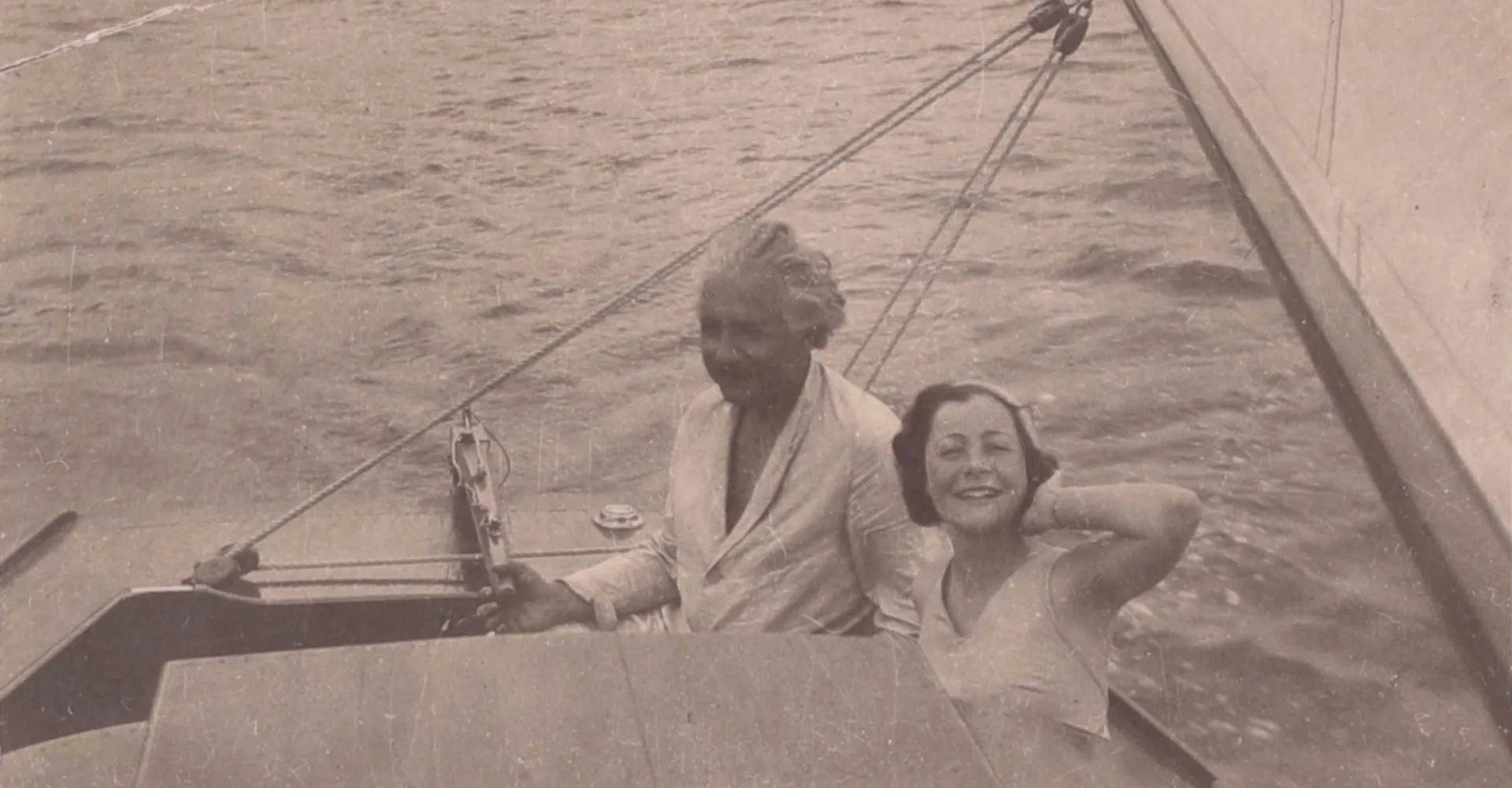
Irene Stern and Albert Einstein sailing on the „Tümmler“, Caputh, around 1930; Jewish Museum Berlin, gift of the Salinger family
Caputh Stars
The Discovery of a Friendship
Six kilometers south of Potsdam, in 1929, Albert Einstein built a summer residence, situated in Caputh and in the immediate vicinity of the house of the Stern family from Berlin. The discovery of a friendship.
“I often went sailing with Einstein,” the 93-year-old Irene Salinger (née Stern) told me when I visited her in California in 2004. It was a comment I’ll never forget, being one of the most unexpected I ever heard in the countless conversations I have had with German-Jewish survivors and emigrants over the last twenty-two years. “Here we are,” said the elegant Irene, as she showed me a photo of herself as a radiant 20-year-old next to the most famous man in the world onboard his sailboat “Tümmler” (“Dolphin”). And thus I learned about the wonderful story of a neighborly friendship in picturesque Caputh, south of Potsdam.
Irene Salinger was the oldest daughter of the government master-builder Adolf Stern and his wife Elsbeth née Salomon. Elsa and Albert Einstein and the Sterns met each other in Berlin in the first half of the 1920s and became friends. In 1926, the Sterns built a summerhouse on the property they had purchased a few years earlier on a gentle hillside above Templiner See, a lake on the edge of Caputh, a town in Brandenburg. They hoped that relatives or maybe even particularly interesting neighbors would move in next door. They didn’t have to wait very long.
On Albert Einstein’s fiftieth birthday in 1929, the magistrate of the city of Berlin wanted to present the Nobel laureate, its best-known resident, with a summer residence. The plan turned into a public scandal, however, since the city proved to be incapable of finding an appropriate location. The discussion dragged on, accompanied by antisemitic statements. The quandary led Adolf Stern to offer the city some building land on his own property. To no avail. When his patience started wearing thin, Einstein bought the plot and built a house himself. Shortly before the construction began, the architect Konrad Wachsmann and Albert and Elsa Einstein entered their names in the guestbook of the Einsteins’ future neighbor. Albert added a funny drawing of a stick figure gazing at a sailboat through a telescope. Five months later, the house was finished and as a housewarming gift the Sterns gave the Einsteins their own guestbook, with the inscription: “To our great neighbor – dedicated with admiration – the Sterns – Caputh, September 1929.”
Entry in the Stern family’s guestbook; with friendly permission of Lynda Salinger & Bonhams Auctioneers
The Einsteins enjoyed three carefree summers next to the Sterns. In 1931, a new neighbor joined them, the Jewish educator Gertrud Feiertag, who had purchased a late-nineteenth-century villa above the Sterns and set up a country boarding school there.
The close friendship between the Einsteins and the Sterns is evidenced in many photographs as well as in letters and texts, such as the poem that Adolf Stern, a passionate stamp collector, gave together with a letter opener to Elsa Einstein, who was totally inexperienced in all things philatelic, “in ardent hope for charitable results” – undamaged postage stamps from Einstein’s global correspondence. The poem, written in 1932, was signed “Adolf (regrettably) Stern.”
Around the same time, Albert Einstein wrote these wise words to his sailing companion, Stern’s daughter Irene, who had since become an aspiring fashion designer:
“O Youth: Do you know that yours is not the first generation to yearn for a life full of beauty and freedom? Do you know that all your ancestors felt as you do – and fell victim to trouble and hatred? Do you know, also, that your fervent wishes can only find fulfillment if you succeed in attaining love and understanding of men, and animals, and plants, and stars, so that every joy becomes your joy and every pain your pain? Open your eyes, your heart, your hands, and avoid the poison your forebears so greedily sucked in from History. Then will all the earth be your fatherland, and all your work and effort spread forth blessings.”1
Albert Einstein and Adolf Stern on the foundation of Einstein’s summer house, Caputh, 1929; Jewish Museum Berlin, gift of the Salinger family
The Einsteins left Caputh in December 1932 bound for the United States, where Albert had a guest professorship at the California Institute of Technology. They were never to return to Germany. On 20 March 1933, their house in Caputh was searched and partially damaged on the basis of the absurd claim that weapons were being stored there. Einstein’s beloved sailboat was confiscated in July. Nevertheless, Gertrud Feiertag was able to rent the house and accompanying property as of May 1933 to accommodate the great increase in the number of pupils.
For the Stern family, as well, the political situation brought substantial changes. Both Adolf Stern and his son in-law Harry Salinger were dismissed from their positions in public service. The first member of the family to leave Germany was the 21-year-old daughter Ingeborg, who traveled to relatives of her mother in California in June 1934. In a letter Albert Einstein wrote from Princeton in March 1935, he expressed his delight that she “finally settled down in the distant West.” And he added, “A real Caputh starlet will surely find its way through the darkness.”2
In 1936, Irene and Harry Salinger also emigrated to California. Elsbeth Stern followed in June 1938. Adolf Stern remained in Berlin, where he tried to rescue as much of the family property and assets as possible. Albert Einstein’s summer residence was confiscated in July 1935 and transferred to the property of the State of Prussia. In 1938, sensing that things would get worse, he tried to help Gertrud Feiertag emigrate. But she stayed and on the morning of 10 November had to experience firsthand how her boarding school was ransacked and the pupils and teachers driven out. The house of the Stern family was also raided. About three months later, after trying since mid-1938, Adolf Stern finally managed to sell the residence, needless to say far below its value.
The Einstein’s and Stern’s residences in Caputh, ca. 1930–1966; Jewish Museum Berlin, gift of Irene Salinger
Far away in California in March 1939, the Stern/Salinger family wrote a short and moving letter to their former neighbor, certainly with the recent violent events in mind:
“‘Memories are the only land from which we cannot be expelled.’ We’re happy and grateful that we could enjoy such wonderful times, during which living together with you, dear Professor, and your dear family in lovely Caputh was a highlight. In these thankful reminiscences, the ‘Caputh stars’ are sending their belated but most heartfelt greetings. Except for my husband, who is unfortunately still in Germany, we have all landed here, but we hope that he will join us as soon as possible. Should the magnificent California entice you to visit again, we would be infinitely happy. With the most heartfelt greetings to you and Miss Margot [Einstein’s stepdaughter],
Yours truly, Elsbeth Stern, Reni Salinger, Harry Salinger, Inga Stern-Fodor, Franz Fodor”3
Adolf Stern was able to leave Germany in August 1939, shortly before the war started, and he arrived in California in October. In his application for American citizenship from 1944 he named his world famous neighbor as a witness and referred to him as a close friend. He and Einstein however apparently never met again in person. Stern died in August 1951 at the age of 78; and Einstein, age 76, died four years later. Gertrud Feiertag did not manage to emigrate despite Albert Einstein’s efforts. She was deported to Auschwitz in May 1943 and murdered there.
For many years already, Albert Einstein’s former summer residence has been visited by tourists from all over the world. The youth welfare center created in 1997 in the building of
the former country boarding school was named after Gertrud Feiertag in 2008. She was posthumously made an honorary citizen of Caputh in 2020, as was Albert Einstein in 1949. Only the Stern family is not remembered officially anywhere in Caputh. Their beautiful home, however, almost 100 years old, has survived and is inhabited. But on site in Caputh, no one can learn of the interrelationships among all the former neighbors.
All the more fortunate is the stroke of fate that these neighborly relations are portrayed in the collections of the Jewish Museum Berlin. Our sincere gratitude goes to Irene, Thomas, and Lynda Salinger for donating their significant family collection to the Jewish Museum Berlin.
Aubrey Pomerance. Since 2001, Aubrey Pomerance has been Director of Archives at the Jewish Museum Berlin and the local branch of the archives of the Leo Baeck Institute New York and the branch of the Wiener Holocaust Library.
This article was first published in 2023 in issue 25 of the print edition of the JMB Journal.
Herbert Sonnenfeld, Brochure of the Jewish country boarding school, Caputh, around 1933; Jewish Museum Berlin, photo: Roman März; gift of David Friedman
Citation recommendation:
Aubrey Pomerance (2023), Caputh Stars. The Discovery of a Friendship.
URL: www.jmberlin.de/en/node/10146
- Albert Einstein Archives, Hebrew University of Jerusalem, 51-870. English from: Albert Einstein, The Human Side, selected and edited by H. Dukas and B. Hoffmann, Princeton: Princeton University Press, 1979, 30 and 128–29. ↩︎
- Einstein used a wordplay on the last name “Stern,” which means “star”; https://www.shapell.org/manuscript/einstein-jewish-refugees-from-germany-hitler-1935/#transcripts ↩︎
- Albert Einstein Archives, Hebrew University of Jerusalem, 30–660. Here, again, is a wordplay on the last name “Stern,” which means “star”. ↩︎

